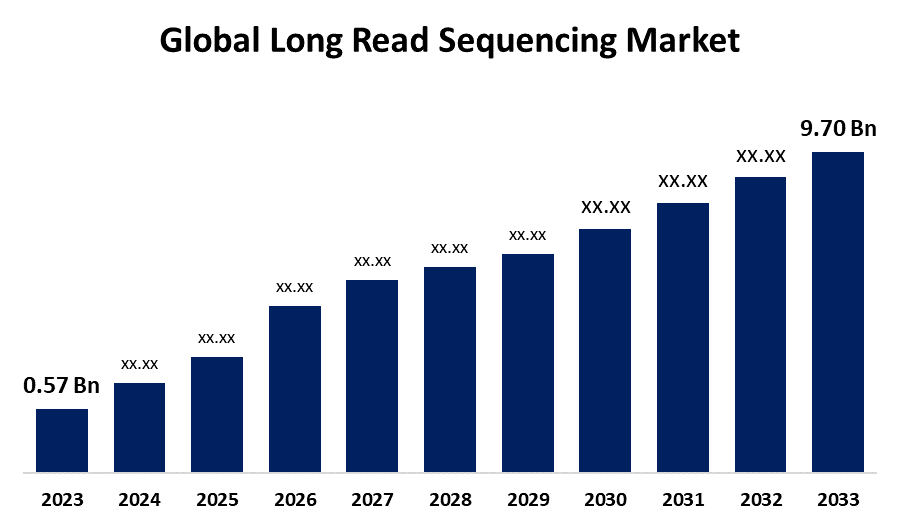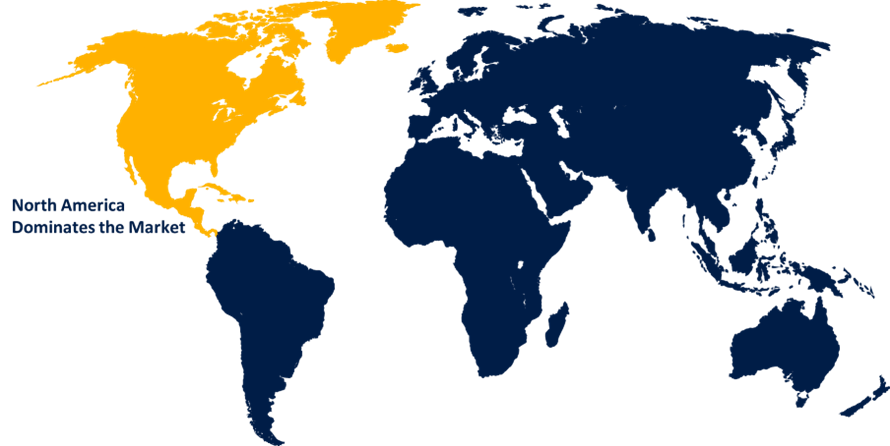Global Long Read Sequencing Market Size, Share, and COVID-19 Impact Analysis, By Product (Instruments, Consumables, and Services), By Technology (Single Molecule Real Time Sequencing, Nanopore Sequencing, and Others), By Application (Whole Genome Sequencing, Targeted Sequencing, Metagenomics, RNA Sequencing, Epigenetics, and Others), and By Region (North America, Europe, Asia-Pacific, Latin America, Middle East, and Africa), Analysis and Forecast 2023 - 2033
Industry: HealthcareGlobal Long Read Sequencing Market Insights Forecasts to 2033
- The Global Long Read Sequencing Market Size was Valued at USD 0.57 Billion in 2023
- The Market Size is Growing at a CAGR of 32.77% from 2023 to 2033
- The Worldwide Long Read Sequencing Market Size is Expected to Reach USD 9.70 Billion by 2033
- Asia Pacific is Expected to Grow the fastest during the forecast period.

Get more details on this report -
The Global Long Read Sequencing Market Size Is Anticipated to Exceed USD 9.70 Billion by 2033, Growing at a CAGR of 32.77% from 2023 to 2033. Long-read sequencing improves at identifying significant gene fusion activities that inform treatment choices for cancer diagnosis. The long read sequencing technologies use longer reads from a single DNA molecule which offers a major advantage over their rivals.
Market Overview
A method for analyzing vast volumes of data is long-read sequencing, also referred to as third-generation sequencing. Real-time sequencing of DNA particles is made possible by this method, leading to the production of lengthy reads. High-quality genome assemblies and the identification of medicinally significant genome components that are invisible with traditional techniques are two possible applications for long-read sequencing. For Instance, in August 2024, a long-read sequencing experiment was launched by the National Precision Medicine (NPM) initiative to better understand Asian genetic diversity. Both PacBio (PacBio) and Oxford Nanopore Technologies (ONT) have been selected to provide sequencing services for the Precision Health Research, Singapore (PRECISE) program. The growing prevalence of genetic diseases like cancer and chromosomal disorders, the growing acceptance of personalized medicine, and the development of newer technologies like third-generation sequencing are the main factors driving the growth in the long-term sequencing market.
Challenges
Long-read sequencing technology presents significant challenges, but it also offers incredible new insights into complex genetic structures. Strong, scalable storage solutions that allow for terabytes of data per sequencing run are necessary for data preservation, processing, and validation due to the enormous volume of data generated by long-read sequencing.
Report Coverage
This research report categorizes the long read sequencing market based on various segments and regions forecasts revenue growth and analyzes trends in each submarket. The report analyses the key growth drivers, opportunities, and challenges influencing the long read sequencing market. Recent market developments and competitive strategies such as expansion, type launch, development, partnership, merger, and acquisition have been included to draw the competitive landscape in the market. The report strategically identifies and profiles the key market players and analyses their core competencies in each sub-segment of the long read sequencing market.
Global Long Read Sequencing Market Report Coverage
| Report Coverage | Details |
|---|---|
| Base Year: | 2023 |
| Market Size in 2023 : | USD 0.57 Billion |
| Forecast Period: | 2023-2033 |
| Forecast Period CAGR 2023-2033 : | 32.77% |
| 2033 Value Projection: | USD 9.70 Billion |
| Historical Data for: | 2019-2022 |
| No. of Pages: | 255 |
| Tables, Charts & Figures: | 110 |
| Segments covered: | By Product, By Technology, By Application, By Region |
| Companies covered:: | Illumina Inc., Pacific Biosciences of California, Inc., Oxford Nanopore Technologies Limited, Quantapore, Inc., Element Biosciences, BGI Genomics, Eurofins Genomics, Stratos Genomics, Inc., MicrobesNG, NextOmics, New England Biolabs, and Others. |
| Pitfalls & Challenges: | Covid-19 Empact, Challenges, Growth, Analysis. |
Get more details on this report -
Driving Factors
Increased adoption of contemporary methods for medical diagnosis is one of the primary factors that drives the expansion long the read sequencing market. Long-read sequencing technology is increasingly popular due to its real-time speed and improved ability to thoroughly analyze entire genomes, which makes it possible to identify rare genetic variants and structural variations that are essential for understanding genetic disorders and diseases like cancer. Concurrent with rising investments in research and development, the use of sequence analysis approaches for academic purposes in medical institutions is also driving the growth in the long-read sequencing market.
Restraining Factors
The limited supply of highly advanced genetic testing facilities, the high cost of installation, and the dearth of specialists with advanced diagnostic skills restrict the long-read sequencing market.
Market Segmentation
The long read sequencing market share is classified into product, technology, and application.
- The consumables segment is estimated to hold the largest market revenue share through the projected period.
Based on the product, the long read sequencing market is classified into instruments, consumables, and services. Among these, the consumables segment is estimated to hold the largest market revenue share through the projected period. Assay kits, reagents, and other consumables have a variety of uses in sequencing processes that drive the market.
- The nanopore sequencing segment is anticipated to hold the largest market share through the forecast period.
Based on the technology, the long read sequencing market is divided into single-molecule real-time sequencing, nanopore sequencing, and others. Among these, the nanopore sequencing segment is anticipated to hold the largest market share through the forecast period. The adoption of nanopore sequencing is significantly influenced by its capacity to directly identify DNA/RNA molecules in real-time without the need for amplification or complex sample preparation.
- The whole genome sequencing segment is anticipated to hold the largest market share through the forecast period.
Based on the application, the long read sequencing market is divided into whole genome sequencing, targeted sequencing, metagenomics, RNA sequencing, epigenetics, and others. Among these, the whole genome sequencing segment is anticipated to hold the largest market share through the forecast period. The ability to access the full-size spectrum of genetic variation in whole genomes, transcripts, and genes has made SMRT sequencing valuable for identifying structural variation in genes.
Regional Segment Analysis of the Long Read Sequencing Market
- North America (U.S., Canada, Mexico)
- Europe (Germany, France, U.K., Italy, Spain, Rest of Europe)
- Asia-Pacific (China, Japan, India, Rest of APAC)
- South America (Brazil and the Rest of South America)
- The Middle East and Africa (UAE, South Africa, Rest of MEA)
North America is anticipated to hold the largest share of the long read sequencing market over the predicted timeframe.

Get more details on this report -
North America is anticipated to hold the largest share of the long read sequencing market over the predicted timeframe. North America has developed regulations for the approval and marketing of genomic testing products and services, a robust informatics network, and significant businesses like Pacific Biosciences. Moreover, the increasing clinical and academic application of genomic techniques in the United States is expected to accelerate the market growth in North America.
Asia Pacific is expected to grow at the fastest CAGR growth of the long read sequencing market during the forecast period. Asia Pacific is characterized by significant investments in the creation of advanced diagnostic methods and a greater presence of large corporations in the expanding market of the region. With a flourishing genomics industry, Japan is a new market in the Asia-Pacific region.
Competitive Analysis:
The report offers the appropriate analysis of the key organizations/companies involved within the long read sequencing market along with a comparative evaluation primarily based on their type of offering, business overviews, geographic presence, enterprise strategies, segment market share, and SWOT analysis. The report also provides an elaborative analysis focusing on the current news and developments of the companies, which includes type development, innovations, joint ventures, partnerships, mergers & acquisitions, strategic alliances, and others. This allows for the evaluation of the overall competition within the market.
List of Key Companies
- Illumina Inc.
- Pacific Biosciences of California, Inc.
- Oxford Nanopore Technologies Limited
- Quantapore, Inc.
- Element Biosciences
- BGI Genomics
- Eurofins Genomics
- Stratos Genomics, Inc.
- MicrobesNG
- NextOmics
- New England Biolabs
- Others
Key Target Audience
- Market Players
- Investors
- End-users
- Government Authorities
- Consulting And Research Firm
- Venture capitalists
- Value-Added Resellers (VARs)
Recent Development
- In June 2024, PacBio, in collaboration with the global consortium for Long-Read Sequencing (CoLoRS), announced the launch of the first publicly accessible and free HiFi long-read sequencing database with worldwide representation; Illumina has named Everett Cunningham as Chief Commercial Officer (CCO) and published DRAGEN v4.3, the most recent version of its DRAGEN software.
- In March 2023, the world leader in array-based and DNA sequencing technologies, Illumina Inc., announced that its first product built on its innovative Illumina Complete Long Read technology is now available for purchase. Human whole-genome sequencing (WGS) assay, which is long-read and high-performance.
- In October 2022, the RevioTM long-read sequencing system, which PacBio a top manufacturer of superior, highly accurate sequencing products, launched would allow users to significantly expand their use of PacBio's renowned HiFi sequencing technology.
Market Segment
This study forecasts revenue at global, regional, and country levels from 2023 to 2033. Spherical Insights has segmented the long read sequencing market based on the below-mentioned segments:
Global Long Read Sequencing Market, By Product
- Instruments
- Consumables
- Services
Global Long Read Sequencing Market, By Technology
- Single Molecule Real Time Sequencing
- Nanopore Sequencing
- Others
Global Long Read Sequencing Market, By Application
- Whole Genome Sequencing
- Targeted Sequencing
- Metagenomics
- RNA Sequencing
- Epigenetics
- Others
Global Long Read Sequencing Market, By Regional Analysis
- North America
- US
- Canada
- Mexico
- Europe
- Germany
- UK
- France
- Italy
- Spain
- Russia
- Rest of Europe
- Asia Pacific
- China
- Japan
- India
- South Korea
- Australia
- Rest of Asia Pacific
- South America
- Brazil
- Argentina
- Rest of South America
- Middle East & Africa
- UAE
- Saudi Arabia
- Qatar
- South Africa
- Rest of the Middle East & Africa
Frequently Asked Questions (FAQ)
-
1. What is the CAGR of the long read sequencing market over the forecast period?The long read sequencing market is projected to expand at a CAGR of 32.77% during the forecast period.
-
2. What is the market size of the long read sequencing market?The Global Long Read Sequencing Market Size is Expected to Grow from USD 0.57 Billion in 2023 to USD 9.70 Billion by 2033, at a CAGR of 32.77% during the forecast period 2023-2033.
-
3. Which region holds the largest share of the long read sequencing market?North America is anticipated to hold the largest share of the long read sequencing market over the predicted timeframe.
Need help to buy this report?